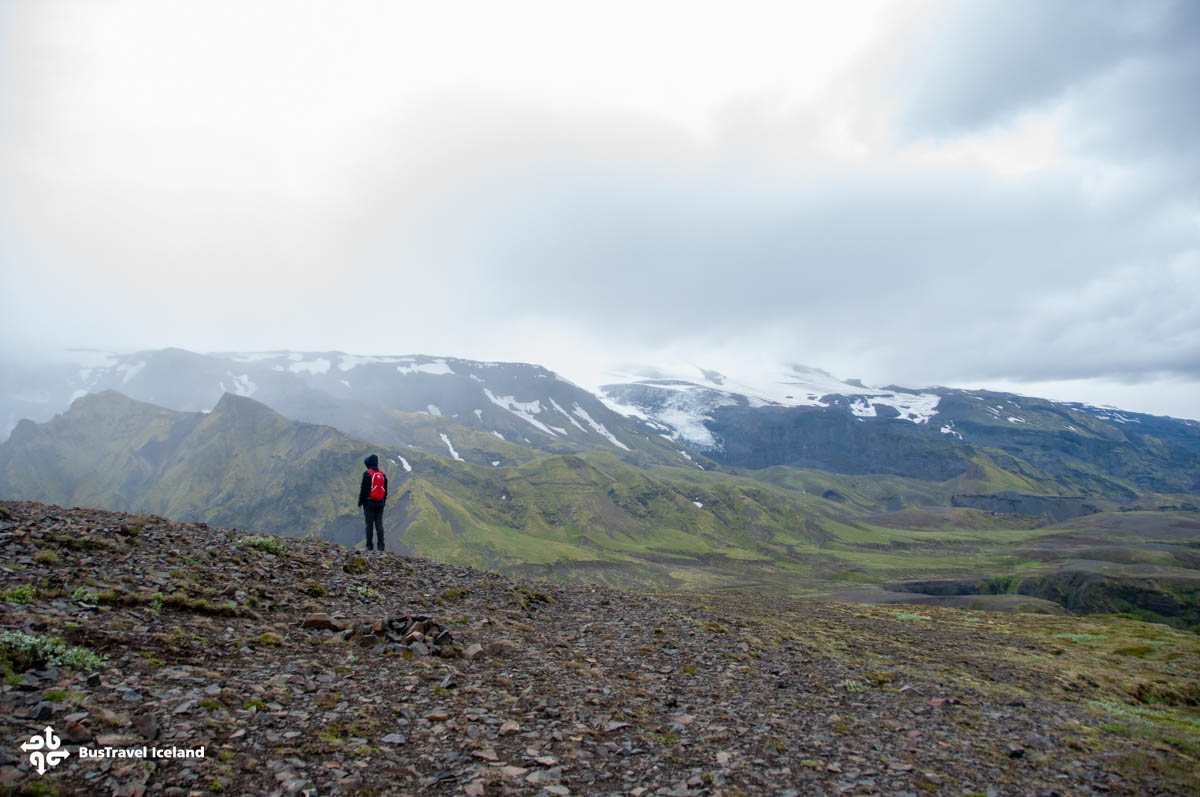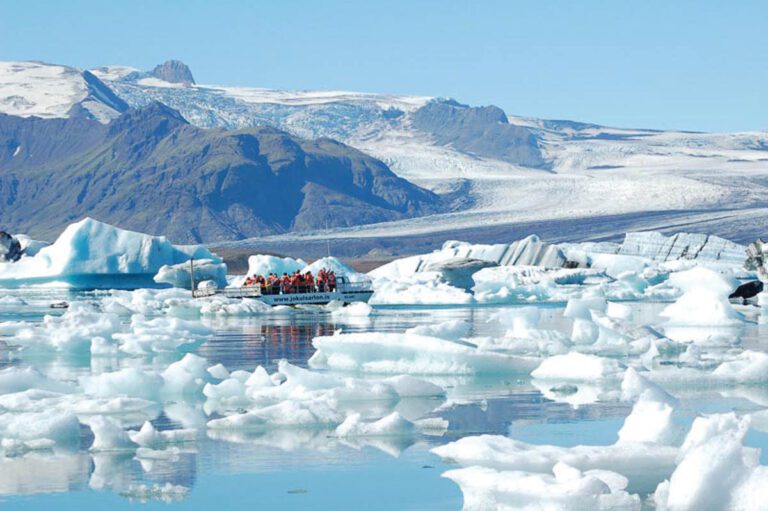Eyjafjallajökull Volcano: Fire, Ice and Ash
- South Iceland
- 22 Jun 2023
Located in South Iceland, the shimmering summit of Eyjafjallajökull greets every traveler journeying along the iconic Ring Road. Its name might be challenging to pronounce, but its story is captivating. A mountain wrapped in a glacier, showing the raw power of the “'land of fire and ice.”

Iceland, one of the world’s most volcanically active countries, is home to an impressive 130 volcanic mountains. Interested in the one that’s made headlines in recent decades? That’s Eyjafjallajökull for you, with its eruption causing the 2010 European flight chaos.
Now, let’s explore more about this famous volcano and find out all you need to know about visiting Eyjafjallajökull.
What Type of Volcano is Eyjafjallajökull and Where it’s Located
Eyjafjallajökull is a type of volcano known as a stratovolcano, which is also called a composite volcano, is shaped like a cone and is made up of lots of layers from dried up lava and bits of rock.
This famous volcano is found in the southern part of Iceland. Eyjafjallajökull – the name is a bit of a mouthful, but it actually means “Island Mountain Glacier” in English. It is located at coordinates 63.6°N 19.6°W and reaches a height of 1,666 meters (5,466 feet) when it includes the glacier top. The mountain beneath the glacier is actually 1651 m (5417 ft) above sea level.

What makes it special is that a large part of it is hidden under a giant ice cap that covers about 80 square kilometers (30 square miles).
Eyjafjallajökull is easy to spot for travelers since it’s near the famous Ring Road in Iceland. It’s also right on a spot where two big pieces of Earth’s crust, called the North American and Eurasian tectonic plates, are moving apart. This makes the area very active with earthquakes and volcanoes. Eyjafjallajökull, with its mix of ice and fire, shows us the amazing and sometimes unpredictable nature of Iceland’s landscapes.
Eyjafjallajokull Volcano’s 2010 Eruption
Timeline
February 26th, 2010: Scientists at the Icelandic weather office noticed some usual seismic activity and that the ground was expanding in a way that isn’t normal. These signs told them that hot, molten rock (which scientists call magma) was moving up from deep in the earth into a space under Eyjafjallajökull where the volcano stores its magma.
March 3-5, 2010: Around 3000 small earthquakes, all between 7-10 kilometers deep, were detected in the vicinity of Eyjafjallajökull volcano.
March 20, 2010: A volcanic eruption starts in Fimmvörðuháls, a pass between Eyjafjallajökull and the neighboring glacier, Mýrdalsjökull. This eruption, although significant, is relatively small and is considered to be a tourist attraction for the eruptive sites due to the spectacular lava fountains and flowing lava streams.
April 14, 2010: The more explosive eruptions and problematic phase of the eruption begins in the caldera of Eyjafjallajökull itself. The eruption occurs under the ice cap, and the interaction between the magma and the glacial ice creates a plume of volcanic ash.
April 15, 2010: The ash cloud from the eruption begins to drift over Europe. Due to concerns about the potential danger the ash could pose to aircraft engines, a large number of flights are canceled across Europe.
April 20, 2010: The eruption intensified, with ash being thrown as high as 9 kilometers into the atmosphere, which further stopped the air traffic in Europe.
May 17, 2010: The eruption enters a more explosive phase, sending a new ash cloud into the atmosphere.
May 20, 2010: The explosive activity decreases markedly, though the eruption continues at a lesser intensity.
May 23, 2010: The eruption comes to an end, leaving behind significant amounts of ash and a drastically reshaped landscape.

Impact of the Eyjafjallajokull Volcano’s 2010 Eruption
The eruption had substantial effects on farming in Iceland due to flooding and ash fallout, and caused unprecedented disruption to air travel across Europe and the North Atlantic, affecting millions of passengers and causing significant economic impact. The event also brought increased scientific and public interest to Iceland’s volcanic activity.
Eyjafjallajökull’s eruptions initially deterred tourists, with many fearing Iceland’s volatility. However, a successful campaign, Inspired by Iceland, highlighted the country’s beauty, overturning the negative image. The eruption also reminded people that Iceland, a breathtaking stopover across the Atlantic, wasn’t so remote. Further, the 2008 economic crisis made Iceland a more affordable destination. These factors turned the nation into a popular global travel spot, leading to a significant rise in visitor numbers.

Eyjafjallajökull Volcano Today
Ever since the dramatic 2010 eruption, Eyjafjallajökull has been pretty chilled out. It now sits quietly under its icy blanket, giving no hints of its once fiery temperament. But don’t be fooled, the scars of its eruption have still left marks on the surrounding landscape, reminding us of nature’s raw power.
Today, it’s a favorite spot for hikers trekking the renowned Fimmvörðuháls trail or experiencing a grand snowmobile ride on its ice cap. Now it’s a magnet for travelers seeking spectacular views and captivating adventurous stories. Whether it’s hiking, sightseeing, or photography that sparks your interest, Eyjafjallajökull serves up a healthy dose of Icelandic charm.

Visiting Eyjafjallajokull Volcano
Eyjafjallajökull is a testament to Iceland’s unique geology. Its grand beauty, dramatic past, and the surrounding landscape offer insights into volcanic activity and the power of nature. And you’re looking to experience a glacier volcano in Iceland? Eyjafjallajökull comes highly recommended.
The Best Time to Visit Eyjafjallajokull
The optimal time to visit Iceland for favorable weather conditions is during the summer months (June to August). However, as you may already be aware, Icelandic weather is known for its unpredictability. Remember to check the weather on the day of your travel while you’re here.
It’s important to note that the weather on Icelandic glaciers can be particularly harsh, requiring careful preparation. Here are a few essential tips to consider.
- Dress in Layers: Wear moisture-wicking, warm, and waterproof layers.
- Footwear: Choose waterproof hiking boots with sturdy soles.
- Head and Hand Gear: Bring a warm hat, gloves, and a neck scarf.
- Sunglasses and Sunscreen: Protect against glare and UV rays.
- Backpack: Carry a waterproof backpack with essentials.
- Safety Equipment: Use necessary safety gear, often provided on guided tours.
Planning a glacier visit without an experienced guide isn’t advisable. For safety and enjoyment at Eyjafjallajökull, consider joining guided activities like glacier hiking or snowmobiling.

How to Get to Eyjafjallajokull?
By Tour
A popular option that most visitors take to see Eyjafjallajokull is by tour. The guided tours to the South Coast sometimes make an extra stop at the parking lot close to Eyjafjallajökull. Choosing a tour not only takes care of transportation but also provides the added benefit of a knowledgeable guide who can enlighten you about the area’s interesting geology throughout your journey.

By Car
The drive from Reykjavik to Eyjafjallajökull is around two hours. You’ll need to head southeast along the Ring Road (Route 1). Simply stop at the former location of the Eyjafjallajökull Erupts museum, step out, and marvel at the volcano’s shimmering silver peak. It’s a sight to behold and a fantastic photo opportunity.
Why is Eyjafjallajokull a Must-Visit?
Eyjafjallajökull is a must-visit for anyone intrigued by Iceland’s geology and volcanic activity. Its dramatic 2010 eruption left an indelible mark on the landscape, offering us a tangible look into the country’s seismic vitality. As a living testament to the land of fire and ice, it’s truly an unmissable stop on any Icelandic itinerary.
Best Tours to Visit Eyjafjallajokull
Embark on an adventure with a super jeep tour to Eyjafjallajökull, led by a knowledgeable guide. The Eyjafjallajökull & Thorsmork super jeep tour is an excellent choice for those eager to discover Iceland’s less-trodden paths and awe-inspiring landscapes.
Guided tours heading to Southern Iceland occasionally offer an additional stop, allowing you to enjoy the view of the majestic Eyjafjallajokull and its surrounding landscapes. This break presents a unique opportunity to appreciate Iceland’s authentic countryside charm. On clear, sunny days, prepare yourself for a truly memorable visual journey through the picturesque Icelandic scenery.

Eyjafjallajokull’s Nearby Attractions
Eyjafjallajökull is nestled in Iceland’s diverse southern region, which boasts a range of stunning landscapes and attractions. Don’t miss these highlights when you’re planning a visit to Eyjafjallajökull.
Seljalandsfoss Waterfall
This is one of the most famous waterfalls in Iceland. What makes Seljalandsfoss unique is that you can actually walk behind the waterfall for a unique perspective. It’s about an 18-minute drive away from the waterfall to Eyjafjallajokull.

Skógafoss Waterfall
Just 10 kilometers further east from Eyjafjallajokull, Skógafoss is another magnificent waterfall. It drops 60 meters and is 25 meters wide. On sunny days, you may even see a rainbow in the spray of the waterfall.

Sólheimajökull Glacier
Part of the larger Mýrdalsjökull glacier, Sólheimajökull is an outlet glacier that’s popular for glacier walks and ice climbing tours.

Thórsmörk Nature Reserve
Nestled between three glaciers, including Eyjafjallajökull, Thórsmörk is a hiker’s paradise. It’s filled with diverse landscapes including mountains, glaciers, forests, and river valleys.

Reynisfjara Black Sand Beach
This village is the southernmost in Iceland, and the nearby black sand beach is a must-visit. The beach’s striking black sand and the imposing sea stacks just offshore make it one of the most photographed locations in Iceland.



















